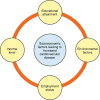Socioeconomic Status and Cardiovascular Outcomes: Challenges and Interventions
- PMID: 29760227
- PMCID: PMC5958918
- DOI: 10.1161/CIRCULATIONAHA.117.029652
Socioeconomic Status and Cardiovascular Outcomes: Challenges and Interventions
Abstract
Socioeconomic status (SES) has a measurable and significant effect on cardiovascular health. Biological, behavioral, and psychosocial risk factors prevalent in disadvantaged individuals accentuate the link between SES and cardiovascular disease (CVD). Four measures have been consistently associated with CVD in high-income countries: income level, educational attainment, employment status, and neighborhood socioeconomic factors. In addition, disparities based on sex have been shown in several studies. Interventions targeting patients with low SES have predominantly focused on modification of traditional CVD risk factors. Promising approaches are emerging that can be implemented on an individual, community, or population basis to reduce disparities in outcomes. Structured physical activity has demonstrated effectiveness in low-SES populations, and geomapping may be used to identify targets for large-scale programs. Task shifting, the redistribution of healthcare management from physician to nonphysician providers in an effort to improve access to health care, may have a role in select areas. Integration of SES into the traditional CVD risk prediction models may allow improved management of individuals with high risk, but cultural and regional differences in SES make generalized implementation challenging. Future research is required to better understand the underlying mechanisms of CVD risk that affect individuals of low SES and to determine effective interventions for patients with high risk. We review the current state of knowledge on the impact of SES on the incidence, treatment, and outcomes of CVD in high-income societies and suggest future research directions aimed at the elimination of these adverse factors, and the integration of measures of SES into the customization of cardiovascular treatment.
Keywords: cardiovascular diseases; epidemiology; risk factors; social class; social determinants of health.
© 2018 American Heart Association, Inc.
Conflict of interest statement
The authors have no financial conflicts of interest to disclose.
Figures




References
-
- Benjamin EJ, Blaha MJ, Chiuve SE, Cushman M, Das SR, Deo R, de Ferranti SD, Floyd J, Fornage M, Gillespie C, Isasi CR, Jimenez MC, Jordan LC, Judd SE, Lackland D, Lichtman JH, Lisabeth L, Liu S, Longenecker CT, Mackey RH, Matsushita K, Mozaffarian D, Mussolino ME, Nasir K, Neumar RW, Palaniappan L, Pandey DK, Thiagarajan RR, Reeves MJ, Ritchey M, Rodriguez CJ, Roth GA, Rosamond WD, Sasson C, Towfighi A, Tsao CW, Turner MB, Virani SS, Voeks JH, Willey JZ, Wilkins JT, Wu JH, Alger HM, Wong SS, Muntner P, American Heart Association Statistics C and Stroke Statistics S Heart Disease and Stroke Statistics-2017 Update: A Report From the American Heart Association. Circulation. 2017;135:e146–e603. - PMC - PubMed
-
- Stringhini S, Carmeli C, Jokela M, Avendaño M, Muennig P, Guida F, Ricceri F, d’Errico A, Barros H, Bochud M, Chadeau-Hyam M, Clavel-Chapelon F, Costa G, Delpierre C, Fraga S, Goldberg M, Giles GG, Krogh V, Kelly-Irving M, Layte R, Lasserre AM, Marmot MG, Preisig M, Shipley MJ, Vollenweider P, Zins M, Kawachi I, Steptoe A, Mackenbach JP, Vineis P, Kivimäki M, Alenius H, Avendano M, Barros H, Bochud M, Carmeli C, Carra L, Castagné R, Chadeau-Hyam M, Clavel-Chapelon F, Costa G, Courtin E, Delpierre C, D’Errico A, Dugué P-A, Elliott P, Fraga S, Gares V, Giles G, Goldberg M, Greco D, Hodge A, Irving MK, Karisola P, Kivimäki M, Krogh V, Lang T, Layte R, Lepage B, Mackenbach J, Marmot M, McCrory C, Milne R, Muennig P, Nusselder W, Panico S, Petrovic D, Polidoro S, Preisig M, Raitakari O, Ribeiro AI, Ribeiro AI, Ricceri F, Robinson O, Valverde JR, Sacerdote C, Satolli R, Severi G, Shipley MJ, Stringhini S, Tumino R, Vineis P, Vollenweider P, Zins M. Socioeconomic status and the 25 × 25 risk factors as determinants of premature mortality: a multicohort study and meta-analysis of 1·7 million men and women. Lancet. 2017;389:1229–1237. - PMC - PubMed
-
- Lynch JW, Kaplan GA, Cohen RD, Tuomilehto J, Salonen JT. Do Cardiovascular Risk Factors Explain the Relation between Socioeconomic Status, Risk of All-Cause Mortality, Cardiovascular Mortality, and Acute Myocardial Infarction? Am J Epidemiol. 1996;144:934–942. - PubMed
Publication types
MeSH terms
Grants and funding
- R01 HL089650/HL/NHLBI NIH HHS/United States
- P30 DK111024/DK/NIDDK NIH HHS/United States
- R01 NS064162/NS/NINDS NIH HHS/United States
- T32 HL130025/HL/NHLBI NIH HHS/United States
- P01 HL086773/HL/NHLBI NIH HHS/United States
- Z99 HL999999/ImNIH/Intramural NIH HHS/United States
- DP3 DK094346/DK/NIDDK NIH HHS/United States
- R61 HL138657/HL/NHLBI NIH HHS/United States
- R01 HL095479/HL/NHLBI NIH HHS/United States
- RF1 AG051633/AG/NIA NIH HHS/United States
- U10 HL110302/HL/NHLBI NIH HHS/United States
- P20 HL113451/HL/NHLBI NIH HHS/United States
- P01 HL101398/HL/NHLBI NIH HHS/United States
LinkOut - more resources
Full Text Sources
Other Literature Sources

